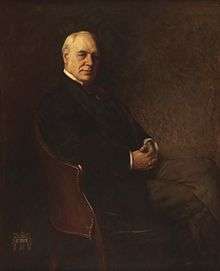Sir John Williams, 1st Baronet, of the City of London

.jpg)
Sir John Williams, 1st Baronet, GCVO (6 November 1840 – 24 May 1926), was a Welsh physician, who attended Queen Victoria of the United Kingdom and was raised to the baronetcy by her in 1894. He is remembered chiefly for his contribution to the collection of the National Library of Wales. He resided for part of his life at Plas Llansteffan, a house he acquired by lease.
Education and professional career
Williams was born in Gwynfe hamlet, Carmarthenshire, the son of a Welsh Congregational minister David Williams (September 1802 – September 1842), who was full younger brother to Morgan Williams (August 1800 – March 1892) who had 11 children as paternal first cousins to Sir John Williams. The young John Williams (1840–1926) went to school in Swansea, then to the University of Glasgow, and finally to University College Hospital, London, to complete his medical studies; among other disbursements on his death he bequeathed two thousand pounds to the University College Hospital, London. In 1872 he married Mary Hughes, but they had no children and neither did the four siblings of John Williams (1840–1926). In 1886, John Williams (1840–1926) became a private doctor to the royal family. As well as his career as an obstetric surgeon in London, he helped set up a Welsh hospital in South Africa during the Boer War, and was involved in the campaign against tuberculosis in his native country.
Contribution to the National Library


Sir John's leisure hours were largely spent in the acquisition of a large private library, and in 1898, influenced by the palaeographer John Gwenogvryn Evans, he acquired the Peniarth collection of manuscripts. These were donated to the new National Library of Wales when it was built at Aberystwyth. In 1907 he was appointed the first President of the National Library, and two years later he came to live at Aberystwyth. In 1913 he became President of the University College of Wales, Aberystwyth (now Aberystwyth University). On his death, he bequeathed the remainder of his books, plus a large sum of money, in trust to the National Library, and the other moiety of the residuary estate in trust to the University College of Wales, Aberystwyth (now Aberystwyth University).
Sir John Williams presented a collection of some 1,200 manuscripts in total to the National Library, which divide into three groups: the five hundred manuscripts from the Hengwrt-Peniarth collection; the Llanstephan collection of two hundred manuscripts, including a hundred and fifty four from the Shirburn Castle library; and, five hundred Additional Manuscripts that Sir John collected from various sources. The majority of the manuscripts were acquired between 1894 and 1905 as part of the campaign to establish the National Library of Wales in Aberystwyth. In 1905, after it had been confirmed that the National Library would be in Aberystwyth, Sir John almost entirely ceased to collect manuscripts.[1]
A collection of more than 25,000 volumes of printed books were either donated in his lifetime or bequeathed to the National Library by Sir John Williams. The 193 books and pamphlets that he purchased from Shirburn Castle are considered the most valuable group in the collection as they include important examples of the earliest Welsh printed literature. But other parts of the collection are also important, such as the editions of Arthurian romance, which include the only incunabulum, Lancelot du Lac (1488), and a copy of all of the Kelmscott Press publications. There is much Welsh interest material comprising both the items that Sir John acquired individually for their bibliographical features and collections that he brought, either intact, such as the 4,558 volume library of John Parry, Llanarmon-yn-lâl, or portions of libraries, including those of Reverend John Jenkins, Kerry and Reverend Robert Williams, Rhydycroesau. This resulted in duplication of early Welsh books and a collection that is rich in variants of the same edition.[1]
Sir John Williams also collected pictorial records of Welsh life and culture, via his network of contacts in the art trade, which provided a solid foundation for the National Library's collections of maps and art. This includes a set of S. H. Grimm's prints and drawings of Wales, plates of Buck's views of Wales, drawings by Landseer, aquatints by Sandby, and Thomas Rowlandson's drawings of his 1796 tour of Wales. There are also pictures attributed to masters such as Van Dyck, Gainsborough and Turner.[1]
Jack the Ripper accusation
Sir John was accused of the Ripper crimes in a 2005 book, Uncle Jack, written by one of the surgeon's supposed descendants, Tony (Michael Anthony) Williams, and co-authored by Humphrey Price.[2] The authors assert that the victims knew the doctor personally and that they were killed and mutilated in an attempt to research the causes of infertility. The book also asserts that a badly blunted surgical knife, which belonged to Sir John Williams, was the murder weapon.[3] Serious doubts were raised by others about the authors' competence and motivation.[4][5]
References
- 1 2 3 Jones, E. D. (1940). "The Sir John Williams Collection". National Library of Wales Journal. 1 (4): 194–210. Retrieved 23 November 2015.
- ↑ Williams, Tony; Price, Humphrey (2005). Uncle Jack. London: Orion. ISBN 978-0-7528-6708-3
- ↑ Thompson, Tony (24 April 2005). "Knife clue could solve mystery of the Ripper". The Guardian. Retrieved 11 August 2007.
- ↑ Pegg, Jennifer (October 2005). "Uncle Jack Under the Microscope". Ripper Notes. Inklings Press. 24. ISBN 0-9759129-5-X.
- ↑ Pegg, Jennifer (January 2006). ""Shocked and Dismayed" – An Update on the Uncle Jack Controversy". Ripper Notes. Inklings Press. 25: 54–61. ISBN 0-9759129-6-8.
External links
| Academic offices | ||
|---|---|---|
| Preceded by Stuart Rendel, Baron Rendel |
President of the University College of Wales Aberystwyth 1913–1926 |
Succeeded by Edmund Davies, Baron Edmund-Davies |